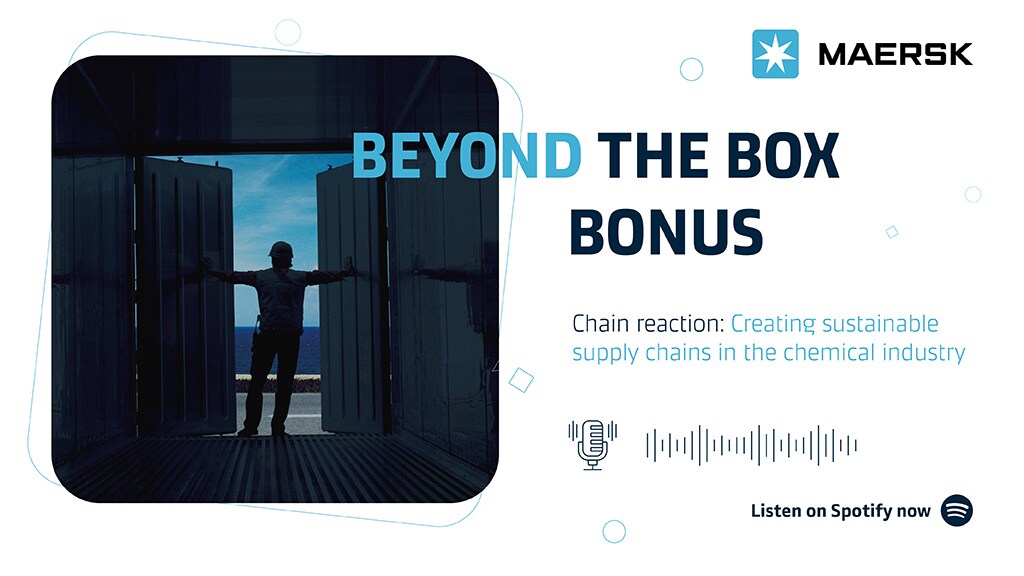For companies in the chemical industry, the race to net zero greenhouse gas (GHG) emissions is on. While many have set their sights firmly on reducing their scope 1 and 2 emissions, the sector’s scope 3 emissions remain a challenge that is compounded by factors such as cost, transparency, and timing.
Nonetheless, there are steps a chemical company can take. These are laid out in a bonus episode of the Beyond the Box podcast, produced by the Financial Times Group’s specialist research and content marketing division, FT Longitude. The episode features insights from industry experts who explain why reducing the sector’s supply chain and logistics GHG emissions is key, and who collaboration and technology have a significant role to play.
The state of play in the chemical industry
Around 96% of all manufactured goods depend on chemical manufacturers, producers, and distributors in some way. Chemicals are used in everything from fertilisers to consumer goods and the sector has become central to the world we live in.
However, chemicals are also a major contributor to climate change. Each year, the industry emits around 2 billion tonnes of CO2 into the atmosphere, which is roughly 5% of global greenhouse gas emissions. Scope 3 emissions, which are the hardest to track, account for more than 70% of that total, according to the European Chemical Industry Council (CEFIC).
“If you look at the greenhouse gas emissions in total globally, almost half comes from supply chains and about one third of that comes from transportation,” says Ann Vereecke, Professor of Operations and Supply Chain Management at the Vlerick Business School in Belgium. “So, it's huge. And there's a lot of potential for improvement.”
Taking action to reduce supply chain GHG emissions
Many businesses, including in the chemical industry, begin by focussing on Scope 1 and 2 emissions, which are the made by a company, or as a consequence of its activities. Increasingly however, attention is slowly turning to Scope 3 supply chain emissions — those produced indirectly by a company’s up- and down-stream value chain. This is where the chemical supply chain comes into the spotlight. However, a survey of senior executives in the industry, conducted by FT Longitude, found that only 29% of chemical businesses are focussed on reducing scope 3 emissions.
There are several approaches that help with decarbonising supply chains. Among them is the introduction of so-called lower GHG emission fuels. As the name suggests, these fuels have low or very low GHG emissions over their life cycle compared to fossil fuels*. Interestingly, some of these new fuels, like methanol and ammonia are chemicals and will be familiar to many in the industry. Advancements in electric vehicle technology are also creating new opportunities for reduced GHG emissions transportation.
*Maersk defines "low GHG emissions fuels” as fuels with 65-80% lifecycle GHG reductions, “very low GHG emissions fuels” as fuels with 80-95% lifecycle GHG reductions, and “lower GHG emissions fuels” as fuels with at least 65% reductions in GHG emissions on a lifecycle basis compared to fossil of 94 g CO2e/MJ
“Many businesses perhaps are only aware of the first level of tier one logistics or supply chain,” says Tim Doggett, CEO of the Chemical Business Association. “They think they're buying from a supplier based in Europe, but actually their supplier is sourcing it from Asia. And then potentially those raw materials have made several journeys in the manufacturing process before it even became a finished product. So, one of the things that businesses really need to do is to analyse their supply chain and look where the products are really coming from. And that's also very important in terms of cost, but also secure supply chains. So as supply chains have become more and more extended, then they become more and more vulnerable.”
Initiating the journey to lower supply chain GHG emissions
Chemical industry leaders are carefully considering the challenges and opportunities ahead to reduce GHG emissions. Understanding the supply chain is the first step and the next is to optimise it.
“If I can use my assets better; my trucks, my trains, my boats, then it means I need less assets in the end,” says Ann Vereecke. “I need less trains. I need less trucks. So, I'll have to invest less in renewing my asset base, which is a financial aspect. It means, on your balance sheet, you can do the same revenue with less assets. So, in the end it means your financial performance will go up.”
In addition, solid partnerships can help share any risks, create demand for change, and unlock new paths to decarbonisation.
“In the chemical supply chain, it is a very collaborative environment already,” says Tim Doggett. “Many of these businesses work incredibly closely together and have great relationships. There are a lot of SMEs, a lot of family-owned businesses, and they really do work together. . . And let's not forget that chemical companies consist of people as well, and I don't know anybody that's got a wish to create more emissions or to be less efficient or to be more dangerous. So, there's a collective desire amongst everybody to work towards the end.”
Find more episodes of the Beyond the Box podcast on Spotify or Apple Podcasts
Sign up to The Logistics Pulse newsletter
You did it, welcome onboard!
We're sorry, but there was a problem sending your contact request.
Please review the form fields and ensure all required information is provided correctly. If the issue persists, please contact our support team for further assistance.
Sign up to The Logistics Pulse newsletter
Receive our insights directly in your mailbox by signing up through this form and enter a world of truly integrated logistics. Get inspired by our selection of articles that help you navigate supply chains, understand industry trends, and shape your logistics strategy. You can unsubscribe anytime.
I agree to receive logistics related news and marketing updates by email, phone, messaging services (e.g. WhatsApp) and other digital platforms, including but not limited to social media (e.g., LinkedIn) from A. P. Moller-Maersk and its affiliated companies (see latest company overview). I understand that I can opt out of such Maersk communications at any time by clicking the unsubscribe link. To see how we use your personal data, please read our Privacy Notification.
By completing this form, you confirm that you agree to the use of your personal data by Maersk as described in our Privacy Notification.














